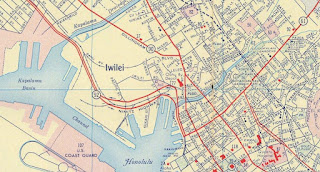Former Hawaii Route 90 is a decommissioned Hawaii State Highway which was once one of the largest signed routes on the Island of O'ahu. Hawaii Route 90 originated in downtown Honolulu following Dillingham Boulevard west from what was Hawaii Route 72 at King Street. West of Honolulu the alignment of Hawaii Route 90 was aligned on the Kamehameha Highway towards Ewa Junction near Pearl City and the Farrington Highway to Ka'ena Point. Below Hawaii Route 90 can be seen at its greatest extent on the 1959 Gousha Highway Map of Hawaii.
Part 1; the history of Hawaii Route 90
Prior to the Statehood the first signed highways within Hawaii Territory came into existence during World War II. During World War II the territory of Hawaii saw an influx of military activity following the attack on Pearl Harbor on December 7th, 1941. Numerous Military Routes and early Hawaii Routes were signed through the Hawaiian Territory to aid military personnel in navigating the islands. Military Highways were assigned US Route style shields whereas lesser highways were assigned an early variation of what is now the Hawaii Route Spade.
A 1946 Army Map of the Island of O'ahu shows the future corridor of Hawaii Route 90 as part of Military Route 1 from Honolulu west to Ewa Junction and Military Route 2 to Makua. A full version of the 1946 Army Map of O'ahu can be seen on hawaiihighways.com here.
Below Hawaii Route 211/Ewa Beach Road can be seen branching from Military Route 2/Farrington Highway.
Circa 1955 following the conclusion of World War II the United States Bureau of Public Roads renumbered the Hawaii Route System. The 1955 Hawaii Route Renumbering saw most of the conventions utilized by the current Hawaii State Route System established. Primary Hawaii Routes were given two-digit numbers whereas Secondary Hawaii Routes were given three-digit numbers. The Hawaii Routes were assigned in sequence for what Island/County they were located on coupled with what Federal Aid Program number they were tied to. In the case of O'ahu the Island was assigned numbers in the range of 60-99. Dillingham Boulevard and Kamehameha Highway from downtown Honolulu to Ewa Junction along with Farrington Highway to Ka'ena Point were assigned as Hawaii Route 90.
As noted in the intro the full extent of Hawaii Route 90 can be seen on the 1959 Gousha Highway Map of Hawaii. Hawaii Route 90 originated in downtown Honolulu following Dillingham Boulevard west from what was Hawaii Route 72 at King Street. West of Honolulu the alignment of Hawaii Route 90 was aligned on the Kamehameha Highway towards Pearl City and the Farrington Highway to Ka'ena Point.
Through Naval Air Station Pearl Harbor Hawaii Route 90/Kamehameha Highway and Hawaii Route 92/Nimitz Highway notably were aligned alongside each other. Below Nimitz Highway (on the left as the two-lane highway) and Kamehameha Highway can be seen running alongside each other west of downtown Honolulu in a Hawaii Department of Transportation photo from 1951 (courtesy hawaiihighways.com).
On August 21st, 1959, Hawaii became the 50th State which saw its profile rise significantly. The Interstate System in Hawaii was authorized as part of the 1960 Statehood Act. The 1960 Statehood Act authorized Interstates H-1, H-2 and H-3 on the Island of O'ahu. Hawaii Route 92 and Hawaii Route 90 from the outskirts of Hickam Airforce Base east to downtown Honolulu was selected to become part of the Queen Liliuokalani Freeway segment of Interstate H-1. Hawaii Route 90 from Hickam Airforce Base west towards Barbers Point was also selected to become part of the Queen Liliuokalani Freeway corridor of Interstate H-1.
Following the completion of Interstate H-1 what was Hawaii Route 90 on Farrington Highway west from Ewa Junction to Hawaii Route 76 was reassigned as Hawaii Route 7101. Below Hawaii Route 7101 can be seen branching onto Farrington Highway from Hawaii Route 99/Kamehameha Highway northbound at Ewa Junction.
West of Hawaii Route 76 to Old Fort Weaver Road what was Hawaii Route 90 on Farrington Highway was retained as part of Hawaii Route 7110. Below the transition on westbound Farrington Highway from Hawaii Route 7101 to Hawaii Route 7110 can be seen.
Following the completion of Interstate H-1 former Hawaii Route 90/Farrington Highway west from Old Fort Weaver Road to Makakilo Drive was relinquished from the State Highway System. The Farrington Highway from Makakilo Drive was bisected by the construction of Interstate H-1. What was Hawaii Route 90 the Farrington Highway from Interstate H-1 Exit 1E west to the entrance of Ka'ena Point State Park was reassigned as Hawaii Route 93. What was Hawaii Route 90 on Farrington Highway from the boundary of Ka'ena Point State Park has been abandoned and repurposed into as part of the Ka'ena Point Trail.

















Comments